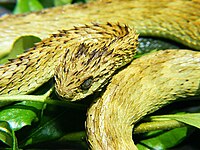Atheris hispida
| Atheris hispida | ||||||||||||||||||||
|---|---|---|---|---|---|---|---|---|---|---|---|---|---|---|---|---|---|---|---|---|
 | ||||||||||||||||||||
| Scientific classification | ||||||||||||||||||||
| ||||||||||||||||||||
| Binomial name | ||||||||||||||||||||
| Atheris hispida Laurent, 1955 | ||||||||||||||||||||
| Synonyms | ||||||||||||||||||||
|
Atheris hispida is a venomous viper species found in Central Africa. Known for its extremely keeled scales that give it an almost bristly appearance.[2] No subspecies are currently recognized.[3]
Common names: rough-scaled bush viper, spiny bush viper,[4][2] hairy bush viper,[2][5] more.
Description
The males of this species grow to maximum length of 73 cm (body 58 cm, tail 15 cm). Females grow to a maximum of 58 cm. The males are surprisingly long and slender compared to the females.[2]
The head has a short snout, more so in males than in females. The eyes are large and surrounded by 9-16 circumorbital scales. Orbits separated by 7-9 scales. The nostril is like a slit and separated from the eye by two scales. The eye and the supralabials are separated by a single row of scales. The supralabials number 7-10, of which the fourth is enlarged.[2]
The body is covered with elongated, heavily keeled scales that give this species a "shaggy", almost bristly appearance. The scales around the head and neck are the longest, decreasing posteriorly. Midbody, the dorsal scales number 15-19. There are 149-166 ventral scales and 35-64 subcaudals. The anal scale is single.[4][2]
Common names
Rough-scaled bush viper, spiny bush viper,[4][2] hairy bush viper,[2][5] rough-scaled tree viper,[5] African hairy bush viper.[6]
The common name "hairy bush viper" should, however, be avoided for this species, as it will likely be confused with the recently described species, A. hirsuta, the specific name for which means "hairy".[5]
Geographic range
Found in Central Africa: DR Congo, south-west Uganda, west Kenya. The type locality given is "Lutunguru, Kivu" (DR Congo).[1]
More specifically, Spawls & Branch (1995) describe the distribution as isolated populations in Kivu and Orientale Provinces in DR Congo, southeastern Ruwenzori in Uganda and the Kakamega Forest in western Kenya.[4]
Behavior
Capable of climbing reeds and stalks, this species is often found basking on top of flowers and terminal leaves. Mostly nocturnal.[7]
Feeding
Feeds on mammals, frogs, lizards and sometimes birds. Sometimes hunts for mammalian prey on the ground.[7]
Reproduction
Females give birth to up to 12 young at a time. Newborns are about 15 cm in length.[7]
Attribution
- Some content on this page may previously have appeared on Wikipedia.
References
- ↑ 1.0 1.1 McDiarmid RW, Campbell JA, Touré T. 1999. Snake Species of the World: A Taxonomic and Geographic Reference, vol. 1. Herpetologists' League. 511 pp. ISBN 1-893777-00-6 (series). ISBN 1-893777-01-4 (volume).
- ↑ 2.0 2.1 2.2 2.3 2.4 2.5 2.6 2.7 Mallow D, Ludwig D, Nilson G. 2003. True Vipers: Natural History and Toxinology of Old World Vipers. Krieger Publishing Company, Malabar, Florida. 359 pp. ISBN 0-89464-877-2.
- ↑ Atheris hispida (TSN 634945) at Integrated Taxonomic Information System. Accessed 25 March 2007.
- ↑ 4.0 4.1 4.2 4.3 Spawls S, Branch B. 1995. The Dangerous Snakes of Africa. Ralph Curtis Books. Dubai: Oriental Press. 192 pp. ISBN 0-88359-029-8.
- ↑ 5.0 5.1 5.2 5.3 World of Atheris: Atheris hispida at kingsnake.com
- ↑ Species Atheris hispida at the Species2000 Database
- ↑ 7.0 7.1 7.2 Mehrtens JM. 1987. Living Snakes of the World in Color. New York: Sterling Publishers. 480 pp. ISBN 0-8069-6460-X.